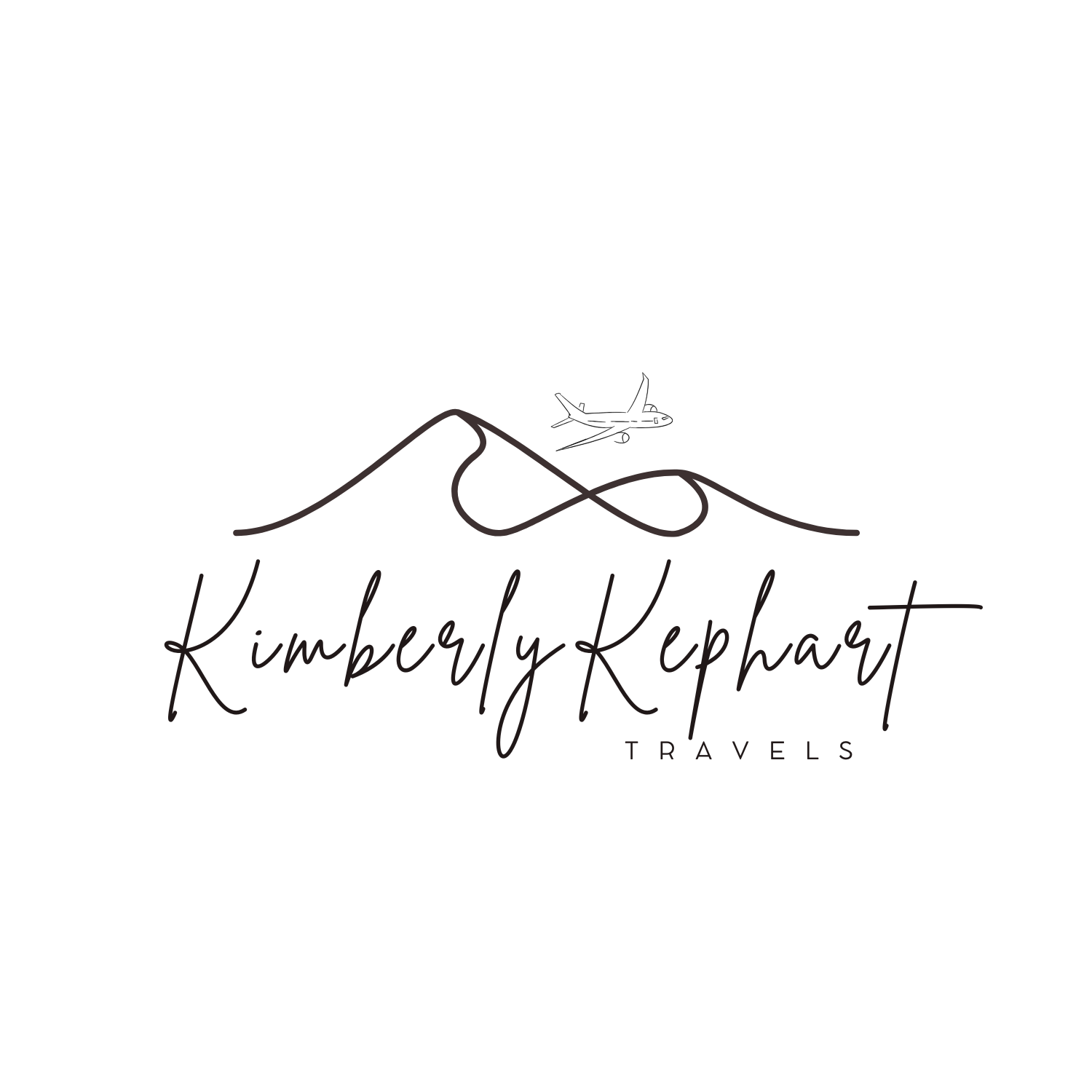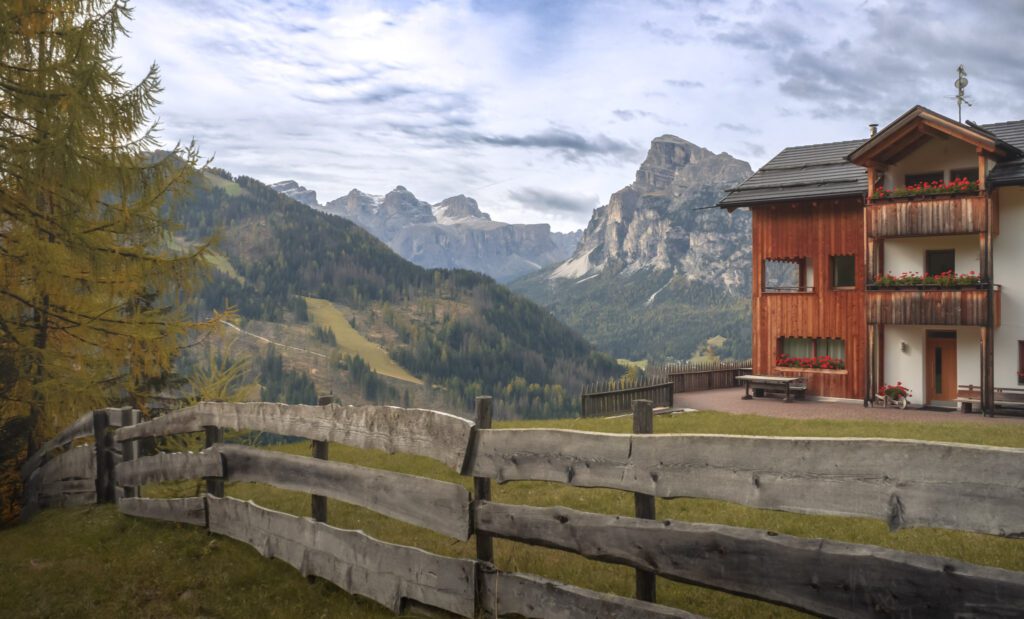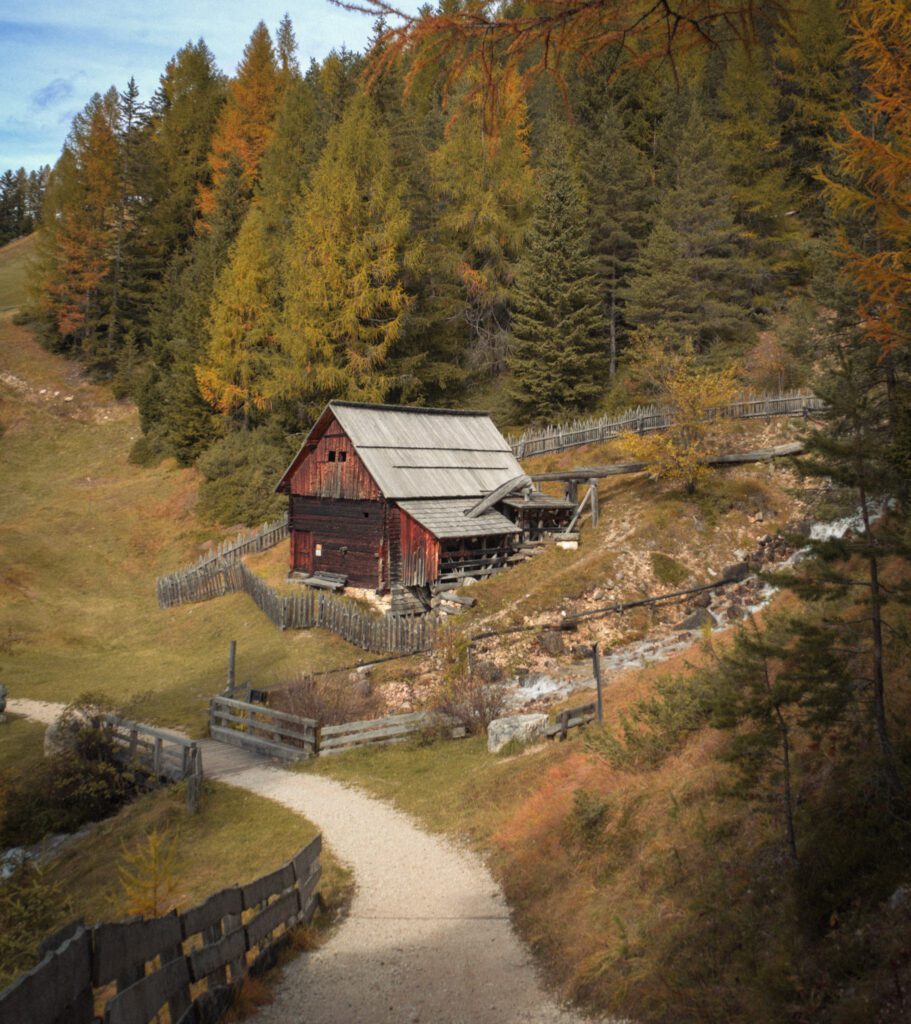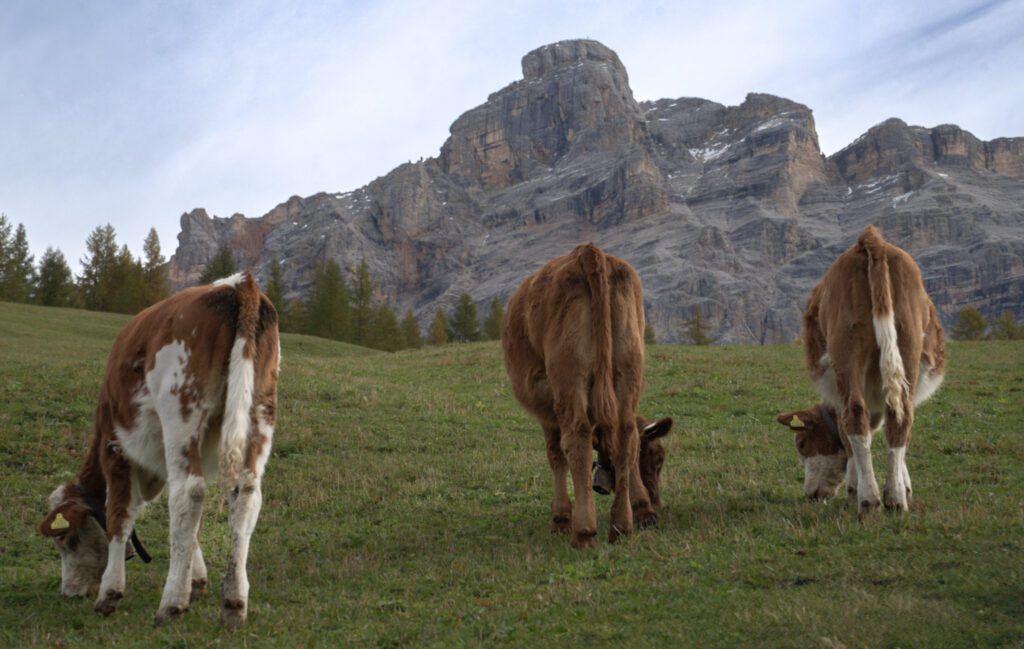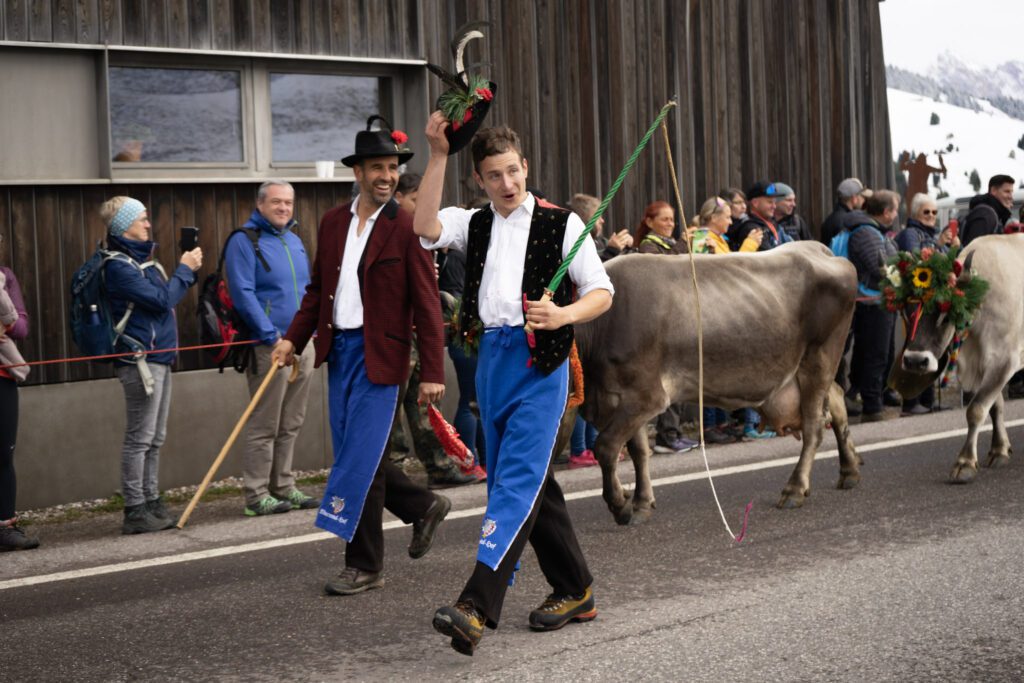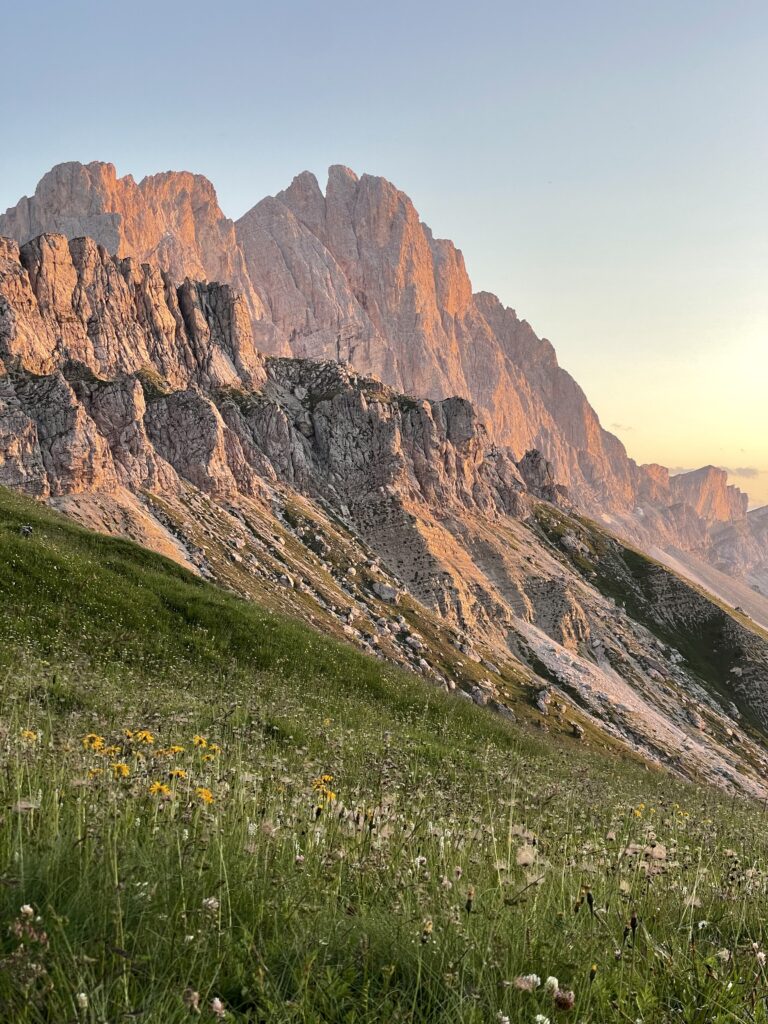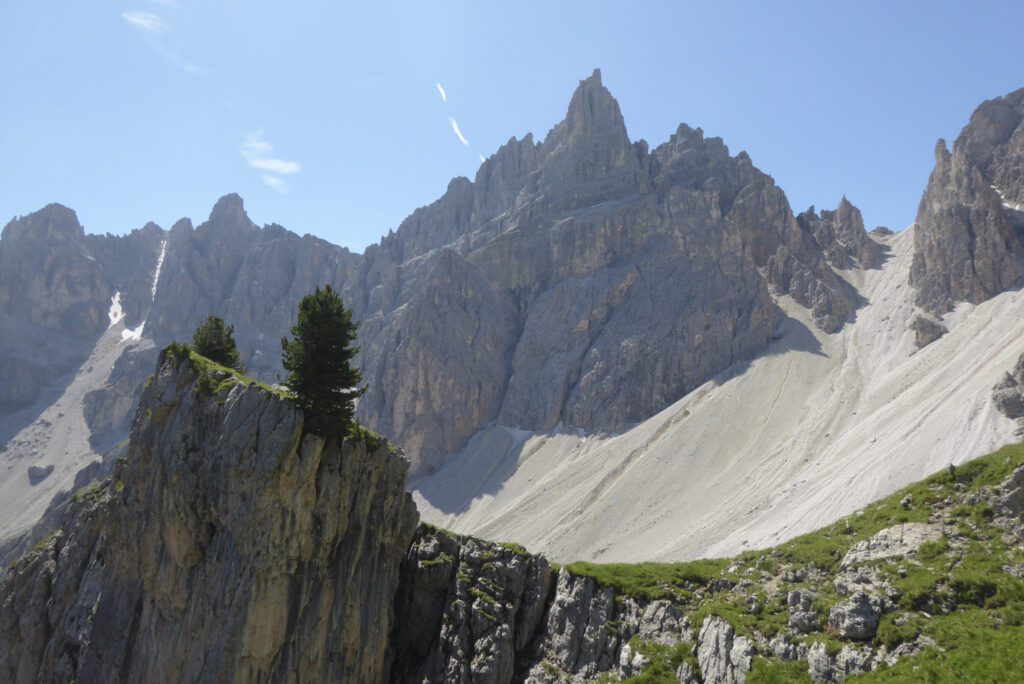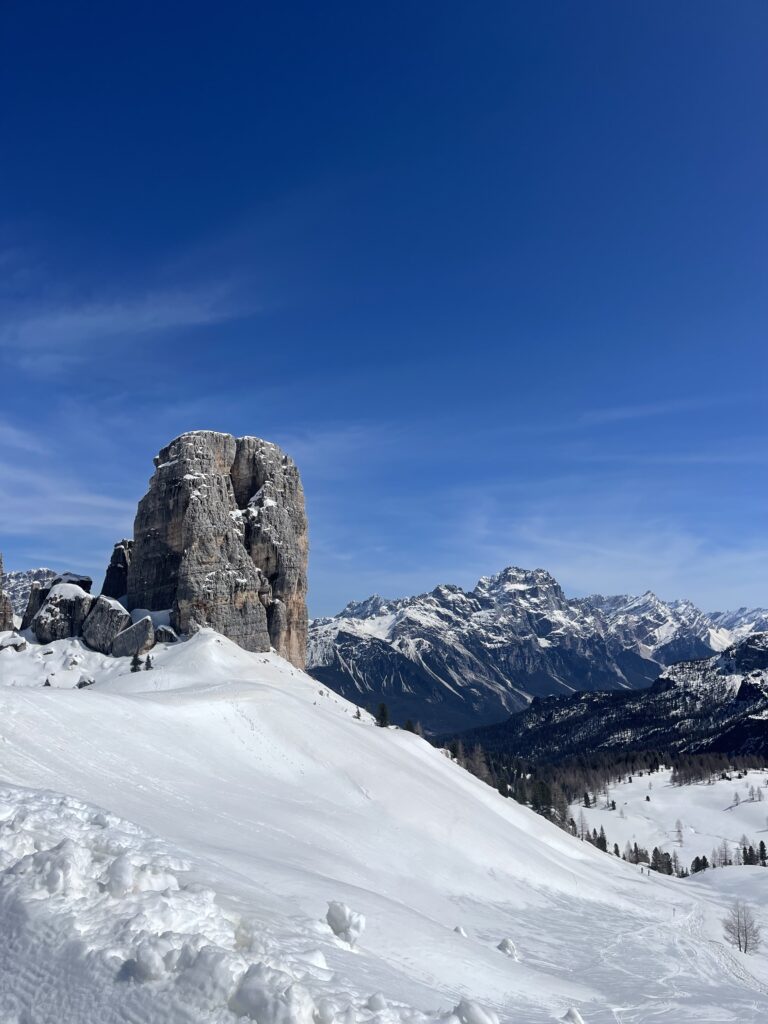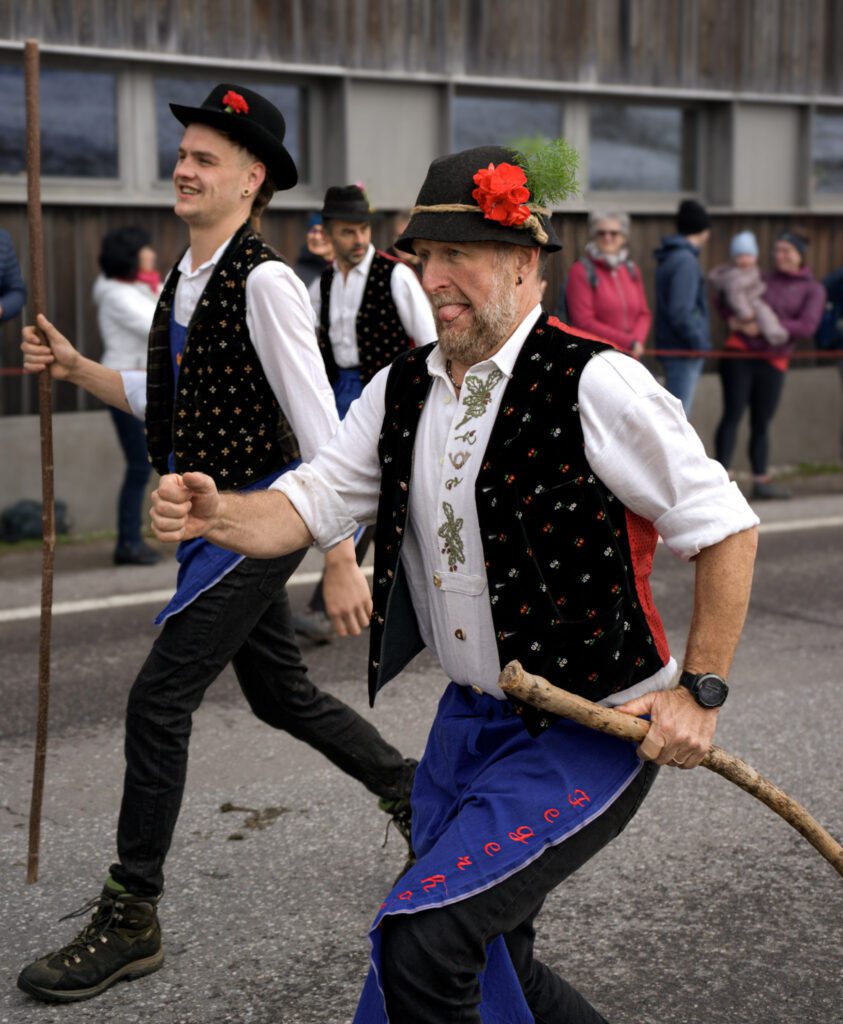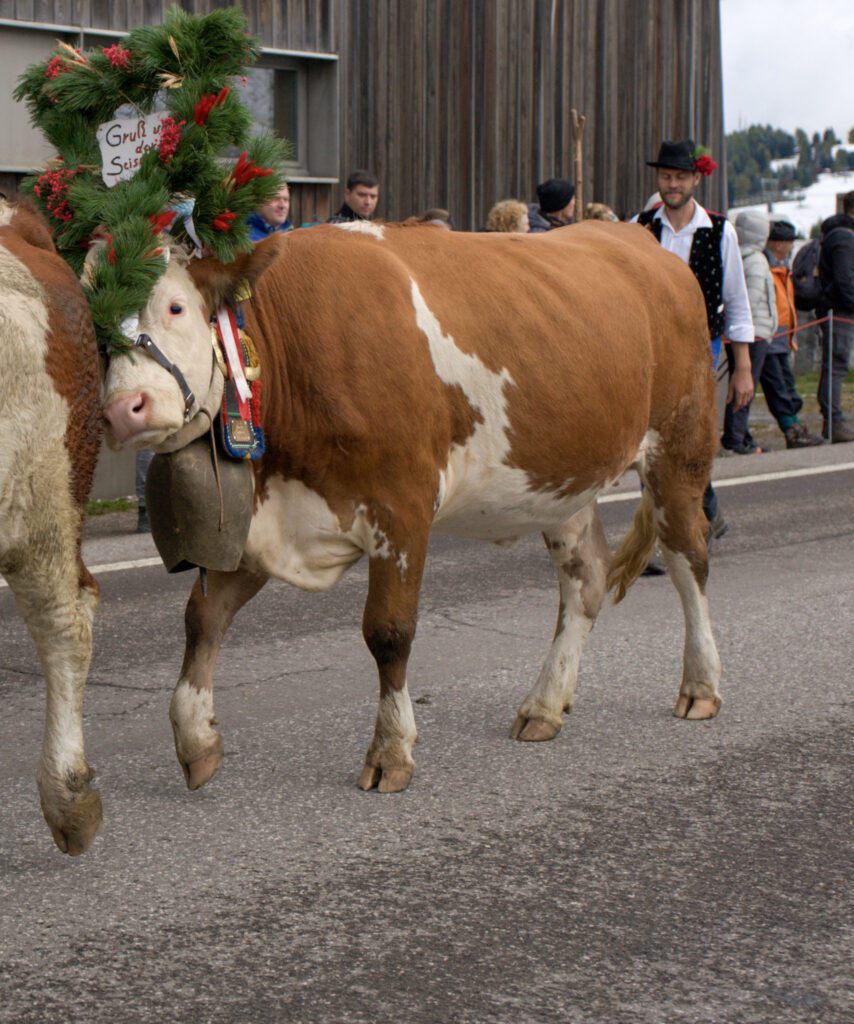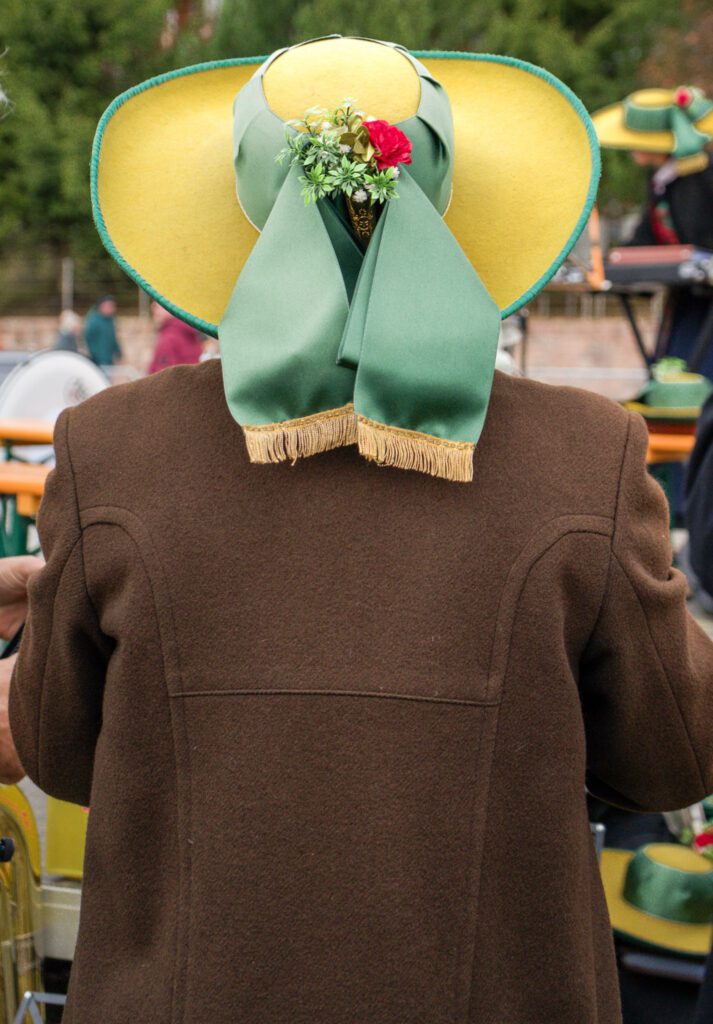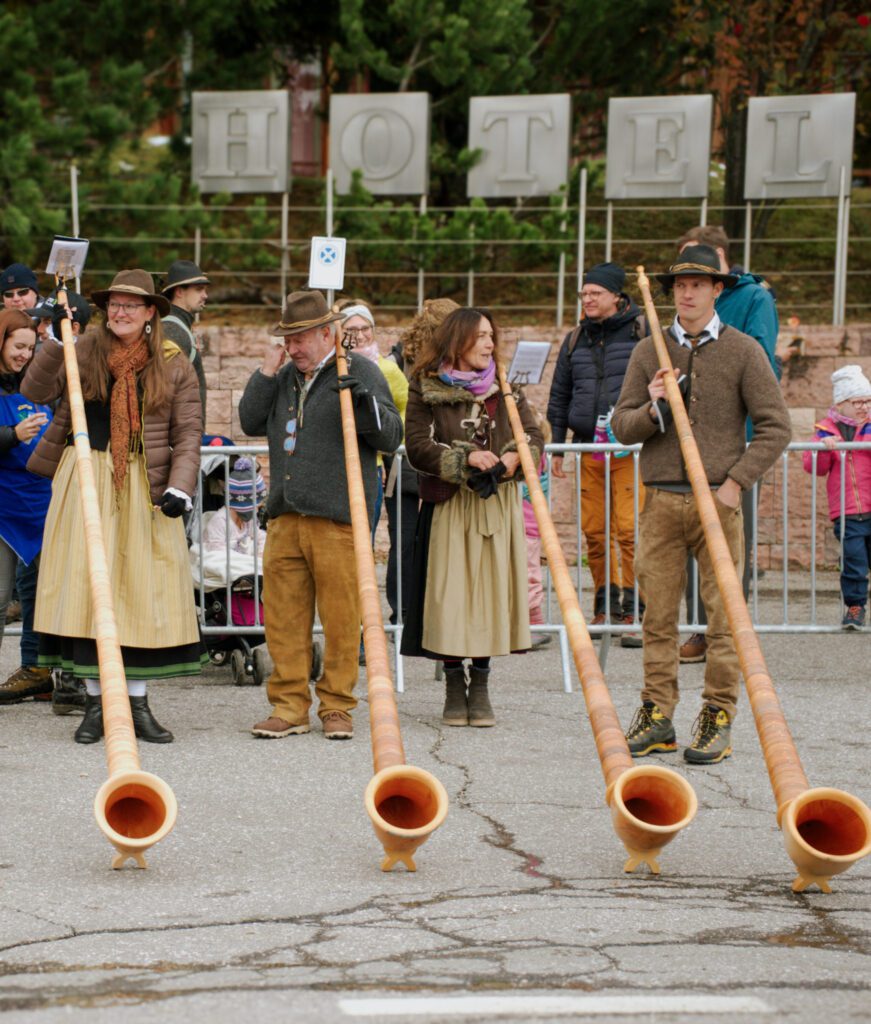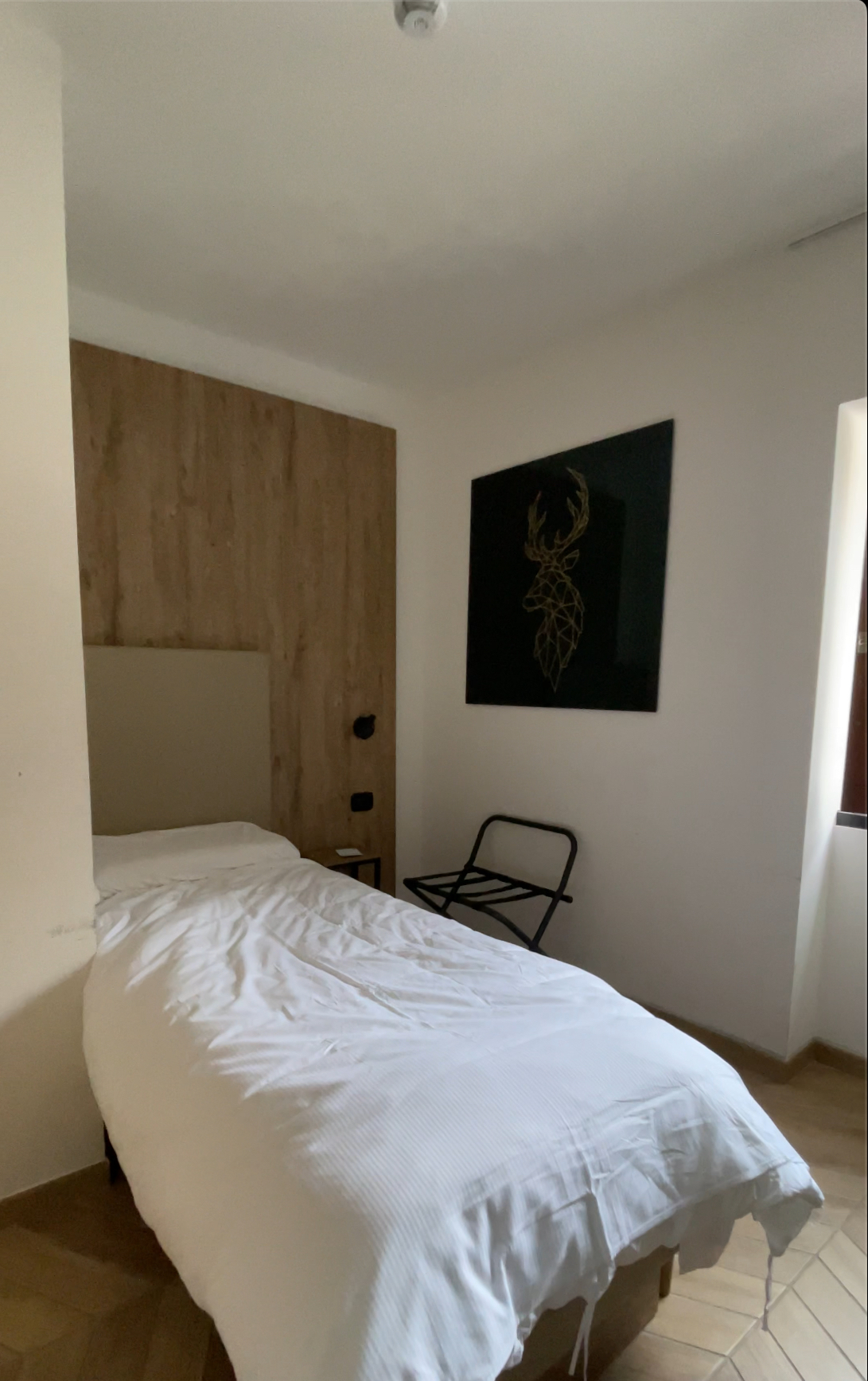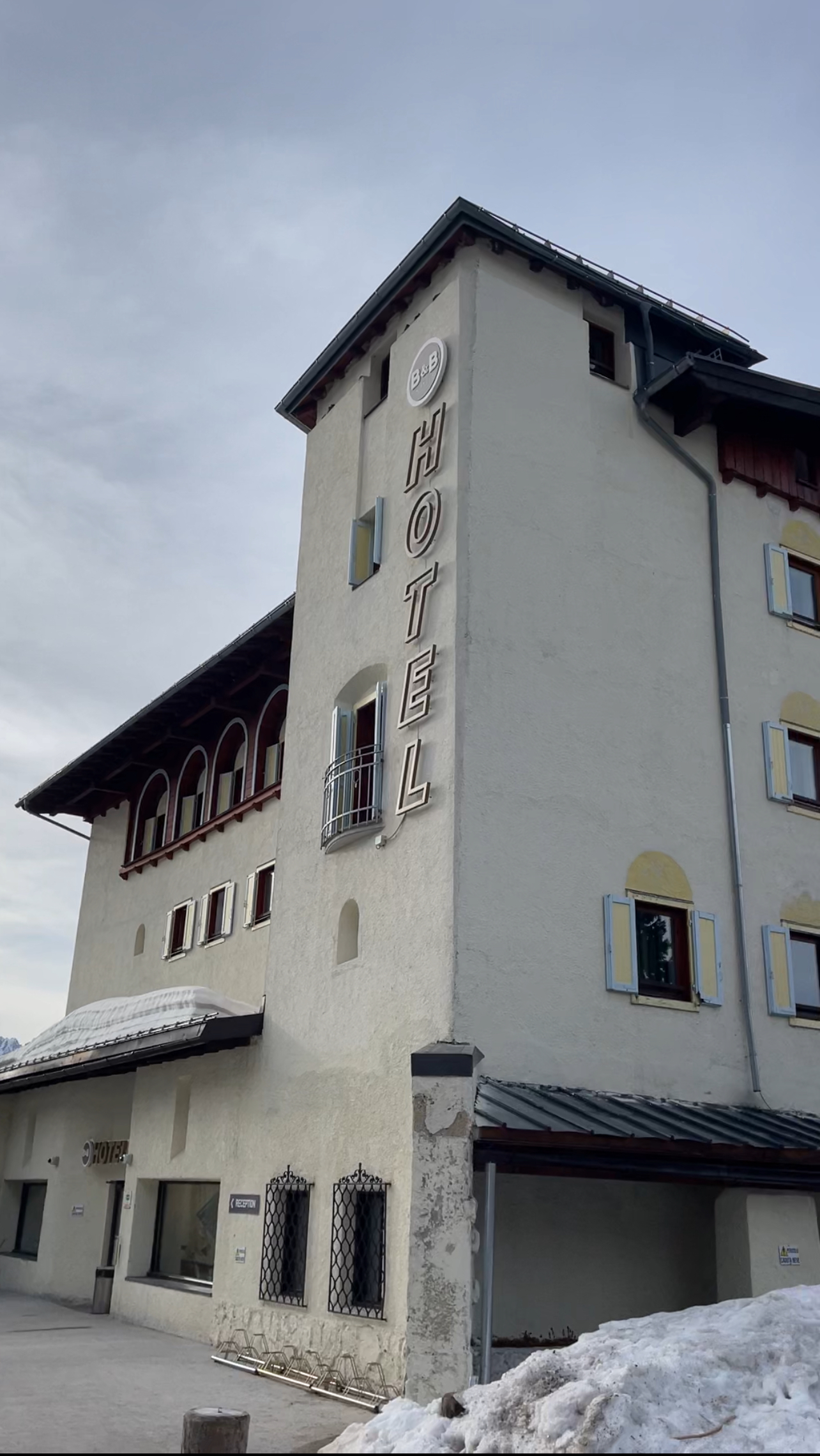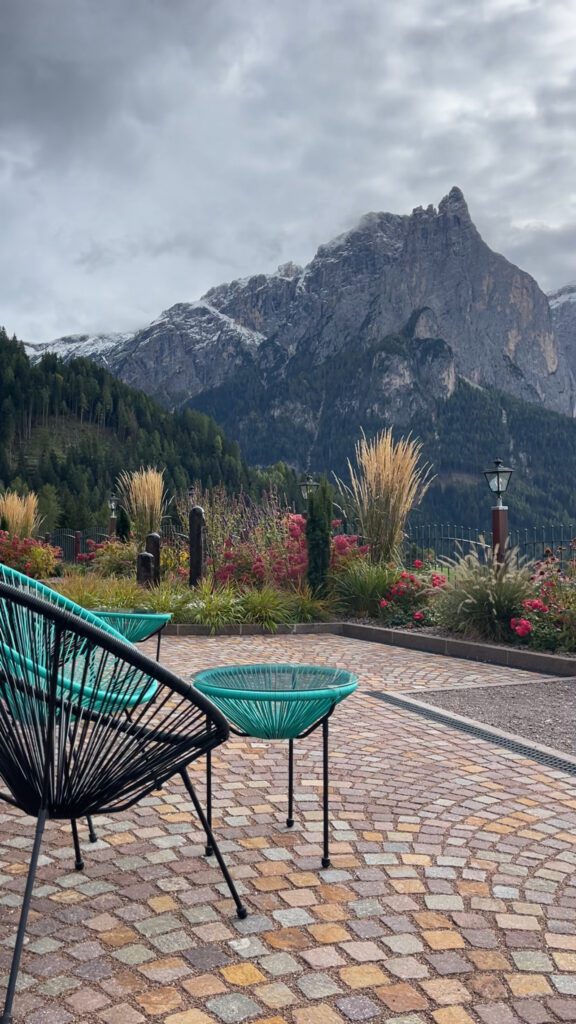A First Timers Guide to the Dolomites: How To Plan your Trip, Where to Stay
There are links to other blogs that focus on hikes and the goal of this first-timer’s guide to the Dolomites is to get you situated and set up for success. If you enjoy this First-timer’s guide to the Dolomites for first-timers, let me know by buying me a coffee or friending me on instagram!
That’s why I created this first-timer’s guide for the Dolomites: to help first-time visitors experience the best of the Dolomites with ease. For those seeking a dedicated resource, this First-Timers Guide to the Dolomites will provide all the information you need!
Disclosure: This post may contain affiliate links, meaning I get a commission if you decide to purchase through my link, at no cost to you.
Dolomites at A Glance
To give you an impression of how massive the Dolomites are here is a Google map that will give you perspective when planning your trip! If you take a look at this map you can see that I have outlined the specific regions that the Dolomites fall in.
There are three regions: Trentino-Alto Adige, Veneto (where I live), and Friuli Venezia Giulia.
The Dolomites are huge as you can see from the map below. This UNESCO World Heritage site covers hectares totaling 141,903
It’s important to know that there are several cities within these regions. Major cities like Bolzano, Cortina, and Belluno which are all big spots to visit in the Dolomites
You don’t have to just hike here there are tons of activities you can participate in while vacationing in the Dolomites.
As a first-time visitor to the Dolomites, you may not be able to cover a lot of ground and remember this is ok.
Hiking, Biking and Skiing are all popular things to do here in the Dolomites.
Year-round Attractions
- Cultural Tours: Visit charming villages and learn about Ladin culture.
- Gastronomy: Savor unique Alpine-Mediterranean fusion cuisine.
- Wellness: Relax in natural hot springs and luxury spas.
Beginner’s Tip: Start with the Cinque Torri area for an introduction to Dolomites climbing, offering routes for all levels and stunning views.
Geology of the Dolomites
Dolomiti, Dolomite Mountains, Dolomite Alps or Dolomitic Alps are mountains in Northeastern Italy. They take their name from the carbonate rock dolomite and was named after the 18th-century French mineralogist Deodat Gratet De Dolomieu!
These beautiful mountains are a part of the southern Limestone Alps and are full of massive peaks. The highest you’ll see here is Marmolada at 3342 meters.
Marmolada is the QUEEN of the Dolomites and she is apart of the Fassa Dolomites between Trento and Belluno. The Highest peak here is Punta Penia (3,343)
Dolomites at A Glance: It’s History
There is also a lot of history in the Dolomites as well.
During the First World War, the front line between the Austro-Hungarian Army ran through the Dolomites.
The war left a lasting impact on the landscape, with remnants of trenches, tunnels, and fortifications still visible today.
There are several hikes where you can see tunnels from the First World War and you can find cemeteries that pay tribute to those who lost their lives in battle.
If you are itching to go on these hikes, you’ll want to check out the Open-air Museums at Cinque Torri, Monte Piana and Mont Lagazuoi. Cinque Torri is a beautiful hike to do and even snowshoe! You can check out the 1st World War Museum here
If you want to see more really interesting WWI trenches and hikes, head further south to Asiago and Mount Pasubio to do the Strada Delle 52 Galleries.
Languages spoken in the Dolomites
The region is unique for its trilingualism. While Italian and German are the primary languages spoken, there’s also the ancient Ladin language, spoken by the first inhabitants of the Dolomites.
Several provinces in the Dolomites were apart of the Austro Hungarian War, it’s scars go as far south into the province or region of Veneto. There is a large influence of different languages due to this. One commune in Asiago (which is further south even still speaks Cimbrian)
Where you’ll See Different Languages in the Dolomites
Since there are three languages, you’ll notice in your search for places to stay, or even if you look at Google Maps you can see that places are written in three different languages.
Where will you notice the Ladin language the most? Belluno, Trentino and South Tyrol. Alta Badia has a strong presence of it and their tourism organization focuses on events to celebrate the ladin culture. If you are in the area I highly recommend attending an event or two.
When making reservations please know that you’ll encounter this and alot of the Rifugios in the Dolomites carry on the tradition of having 3 names from all three languages in honor of the areas history!
If you need examples:
Orteisei (Italian), St. Ulrich (German), and Urtijëi (Ladin)
San Cassiano (Italian), San Ciascian (Ladin), and Sankt Kassian (German)
Badia (Italian) ,Badia(Ladin) , Abtei (German)
Anpezo (ladin) Cortina d’ Ampezzo (Ladin) Hayden (German)
When is the Best Time to Visit The Dolomites?
If you’re contemplating a Dolomite trip, I strongly recommend planning
well in advance. This is particularly important when it comes to securing accommodation. Whether you’re considering Airbnb’s, pensions, or hotels, you’ll find that they start to fill up early in the year.
Pro-Tip➡️The season for hiking in the Dolomites typically begins in mid-June as the snow starts to melt and trails become more accessible. There are lower-elevation hikes you can do in the off-season, typically in the valleys around the Dolomites. The pre-Dolomiti are good options, even if you want to taste the mountains in Northern Italy in the off-season.
June-July in the Dolomites
June-July are warm. Rifugios at lower elevations start welcoming guests in early June, while those at higher altitudes typically open by mid to late June. Afternoon thunderstorms are fairly common throughout the month. By July more places are open and you’ll see the dolomites come to life!
August
August in the Dolomites is packed and very busy. Italians celebrate Ferragosto. My best advice is to stay away from the Dolomites because things tend to be crowded and the prices for hotels are expensive. If you already have made reservations and you are headed to the Dolomites at this time just be aware of the crowds and plan accordingly!
Summer Activities
- Hiking: Explore over 13,000 km of marked trails, from easy walks to challenging treks.
- Via Ferrata: Try these ‘iron path‘ climbing routes, suitable for various skill levels.
- Alta Vias: These High mountain routes are a hikers dream!
- Mountain Biking: Ride through scenic landscapes on well-maintained trails.
september-October-November Weather in the Dolomites
Autumn spans from September to November and is full of color! Temperatures are from 41F to 59F. Peak colors are October 20th to October 31st.
October and November you’ll avoid the crowds. The past two years I have been in the dolomites during this time frame there have been occasional snow storm especially during October and November.
Winter
From December to February– It’s ski season! This is the perfect season to get your skis on and go skiing, snowboarding, and snowshoeing. There are all sorts of wintertime activities in the Dolomites that you can do!
- Skiing and Snowboarding: Enjoy world-class slopes in the Dolomiti Superski area.
- Cross-country Skiing: Glide through serene valleys on hundreds of kilometers of trails.
- Snowshoeing: Explore winter landscapes off the beaten path. Read all about my adventure, I had Snowshoeing in the Dolomites here
Pro-Tip➡️:Check out Dolomiti Superski for more information and you’ll want to check out areas like Val Gardena and Alta Badia!
If you’re staying in areas like Zoldo, Cortina, Belluno, Canazei, Agordo, or Alleghe, the guide offers hotel pickup, making it easy to join the tour. For those staying elsewhere, you can reach out to arrange a custom experience.
Events to be Mindful of in the Dolomites
This section of First-timers guide to the dolomites is meant to remind you that there are certain events in the Dolomites that will increase traffic on the roads. It’s also wise to note any events that might be going on so you don’t have to worry.
1. Seasonal Events & Closures
- Rifugio Opening & Closing Dates: Most mountain huts (rifugi) operate from mid-June to late September, with some reopening for ski season in December. Outside these times, accommodations may be limited.
- Cable Car & Lift Schedules: Many lifts shut down between late autumn (mid-October) and early winter (early December) for maintenance and again in late spring (April–May). Check schedules in advance.
- Off-Season Closures: Smaller towns may have limited dining and lodging options in shoulder seasons (April–May & October–November).
2. Major Outdoor Events
- Maratona dles Dolomites (July) – A massive cycling race with road closures affecting several mountain passes like Passo Gardena and Passo Pordoi.
- Lavaredo Ultra Trail (June) – A 120 km trail running race around Cortina d’Ampezzo; accommodations book out early.
- Sellaronda Ski Marathon (March) – A famous ski mountaineering race; expect ski resorts in the Sella Ronda circuit to be busier.
3. Public Holidays & Festivals
- Ferragosto (August 15th) – This Italian holiday sees a surge in domestic tourism, making trails and accommodations crowded.
- Christmas Markets (Late November–Early January) – Cities like Bolzano, Bressanone, and Ortisei host famous markets, drawing large crowds.
- Krampus Night (December 5th) – Expect parades of terrifying Krampus figures in towns like Ortisei and Dobbiaco.
- Easter Weekend – Many shops and restaurants may close or operate on limited hours.
4. Cultural & Local Events
- South Tyrol Jazz Festival (Late June–Early July) – Music performances in scenic Dolomite settings, particularly in Bolzano.
- Speckfest (October, Val di Funes) – A festival celebrating the region’s famous smoked ham, Speck.
- Alta Badia Wine Skisafari (December) – A ski & wine tasting event in the Alta Badia region.
5. Weather-Related Considerations
- Late Snowfall (May–June) – Some high-altitude trails may still be snow-covered.
- Storm Season (July–August) – Afternoon thunderstorms are common in summer; plan hikes accordingly.
- Early Snowfall (October–November) – Sudden snow can make trails and roads hazardous.
6. Traditional Alpine Events: Almabtrieb (Desmontegada)
- When: Mid-September and Early October
- Where: Various valleys in the Dolomites, including Val di Funes, Val Gardena, and Alta Badia
The Almabtrieb, known locally as the Desmontegada, is the ceremonial return of cows from high alpine pastures to the valleys before winter. Farmers and their families celebrate by dressing their cows in floral crowns and bells, parading them through villages in a lively festival atmosphere.
Why it Matters for Travelers:
- It’s a fantastic cultural experience, offering a glimpse into traditional alpine life.
- Many villages hold celebrations with live music, local food (like speck, cheese, and strudel), and artisan markets.
- Some roads may be temporarily closed or traffic may be slower due to the parades.
Notable Almabtrieb Festivals in the Dolomites:
- Val di Funes (Late September): One of the most famous celebrations, with a vibrant festival in the scenic valley.
- San Cassiano & Badia (Alta Badia, Late September – Early October): A great mix of Ladin culture, traditional food, and festivities.
- Cavalese & Moena (Trentino, Late September): Includes horse parades and cheese-tasting events.
Where Should you Stay in the Dolomites?
There are literally miles and miles (or Kilometers and Kilometers) of the Dolomites where you could stay.
As far as the BEST places to stay in the Dolomites, I personally don’t think there is one best place.
When planning your trip, the first question to consider is, “Which base location should I choose to explore my points of interest?” This is crucial because the Dolomites span across several provinces, including Trento, Bolzano, Belluno, Veneto, Udine, and Pordenone.
Stay in Cortina Di Ampezzo If
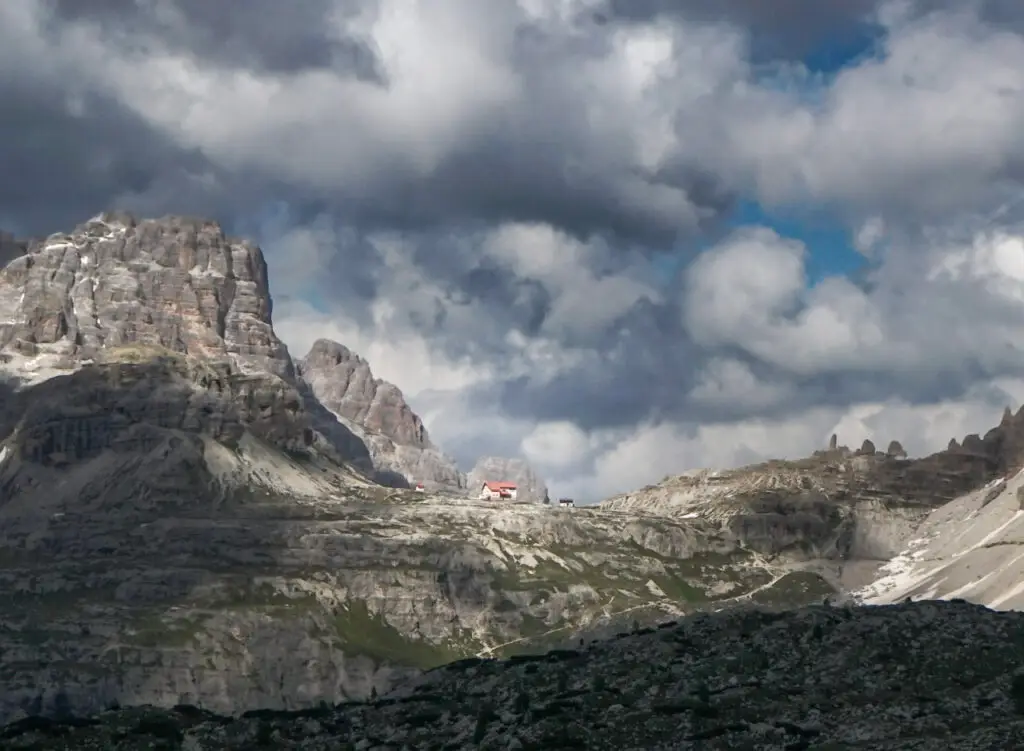
For instance, if your itinerary includes the mesmerizing Lago Di Sorapis and the majestic Tre Cime Di Laverado, Cortina Di Ampezzo or Lago Di Misurina would be ideal base locations. Both areas are enchanting, with Cortina offering a distinctly Italian charm that sets it apart from other places.
Stay in Bolanzo or Orteisei if
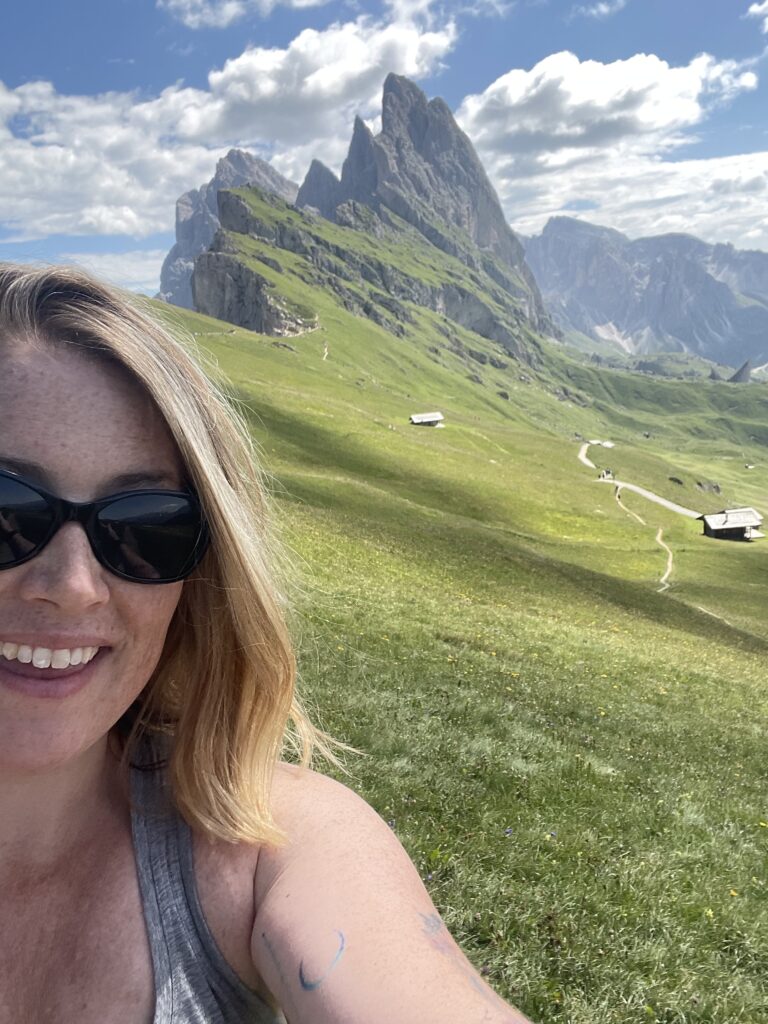
On the other hand, if you’re drawn to the breathtaking landscapes of Seceda and Val Gardena, consider basing yourself in Bolzano or Orteisei.
So, plan wisely, soak in the beauty of each location, and make the most of your Dolomites adventure.
Pro Tip ➡️ While a road trip around the Dolomites can be an exhilarating adventure, it’s important to remember that spending a few days in one area before moving on to the next allows for a more immersive experience.
How to Plan an Itinerary for Your First Trip to the Dolomites
Planning your first trip to the Dolomites can feel overwhelming—there’s so much to see, and the mountain range spans multiple regions! Whether you’re here for hiking, scenic drives, or a mix of adventure and relaxation, this First-timers Guide to the Dolomites will help you create the perfect itinerary based on your interests and travel style.
Define Your Travel Style and Goals While Traveling to the Dolomites
- Are you focusing on hiking, scenic drives, or cultural stops?
Since you love solo hiking, you might want to structure the itinerary around specific trails while including time for rest and exploration. - How many days do you have?
A short trip (3-5 days) will focus on one or two areas, while a longer trip (7+ days) allows for a deeper experience.
Choose a Base or Multiple Stops in the Dolomites
- Single Base: If you prefer slow travel, staying in one location like Cortina d’Ampezzo, Ortisei, or Canazei allows for day hikes and easy access to sights.
- Multiple Bases: For more variety, you could divide your stay between the eastern Dolomites (Cortina) and western Dolomites (Val Gardena or Alta Badia).
Select Key Hikes and Attractions
Here’s a mix of top hikes and viewpoints to structure your itinerary:
Classic & Must-Do Hikes
- Tre Cime di Lavaredo (Cortina d’Ampezzo) – Iconic loop hike, about 3-4 hours.
- Lago di Sorapis (Cortina area) – Stunning turquoise lake, moderate difficulty.
- Seceda Ridgeline (Val Gardena) – Epic views, reachable via cable car with hiking options.
- Alpe di Siusi (Seiser Alm) – Europe’s largest alpine meadow, great for an easy hike.
- Strada delle 52 Gallerie – A historical WWI hike with tunnels and breathtaking views. Okay shameless plug to get you down to Monte Pasubio to hike this stunner of a route!
Lesser-Known & Adventurous Routes
- Lago di Braies to Croda del Becco – A scenic yet challenging trek.
- Via Ferrata Ivano Dibona – A famous via ferrata for adventure seekers.
- Puez-Odle Altopiano (Val Gardena/Alta Badia) – Moon-like landscapes and remote feel.
Plan for Rest Days & Scenic Drives
- Scenic Drives:
- Great Dolomites Road (Bolzano to Cortina) – Stunning mountain pass drive.
- Passo Giau & Passo Falzarego – Dramatic landscapes.
- Val di Funes – A postcard-perfect valley with churches and pastures.
- Rest & Culture:
- Bolzano & Ötzi Museum – Great for a city stop.
- Bressanone (Brixen) & Monastery of Novacella – Beautiful town with history.
- Wellness day at a spa in Val Gardena or Alta Badia.
Consider the Season
- Summer (June-September): Ideal for hiking; rifugi are open.
- Autumn (September-October): Fewer crowds, golden larches, but some rifugi close early.
- Winter (December-March): Ski season! Snowshoeing and Christmas markets.
- Spring (April-May): Shoulder season; some trails may still have snow.
Transportation & Logistics
- Rental Car: Essential for flexibility, but check ZTL zones in towns.
- Public Transport: Buses work well between major towns but limit early/late starts for hikes.
- Cable Cars: Check operating schedules in advance.
Getting to the Dolomites: Best Airports & Transport Options
The Dolomites don’t have their own airport, so you’ll need to fly into a nearby city and continue by car, bus, or train. Here are the best options:
- Venice Marco Polo (VCE) – The most popular choice for International travelers with direct buses to Cortina d’Ampezzo and easy rental car options (2.5 hour drive).
- Treviso (TSF) – A budget-friendly alternative with similar transport options to Venice.
- Verona ( VRN) – Ideal for the western Dolomites (Val Gardena, Alpe di Siusi). Connect via train to Bolzano or rent a car (2.5-hour drive).
- Innsbruck (INN, Austria) – The closest airport for the northern Dolomites, with train and bus connections to Val Pusteria.
- Milan (MXP/LIN/BGY) – Best for long-haul travelers but requires a 3.5- to 4-hour journey by car or train.
Still trying to find the best deal on flights to Italy to explore the Dolomites? Use this handy dandy tool below to search flights! ⬇️
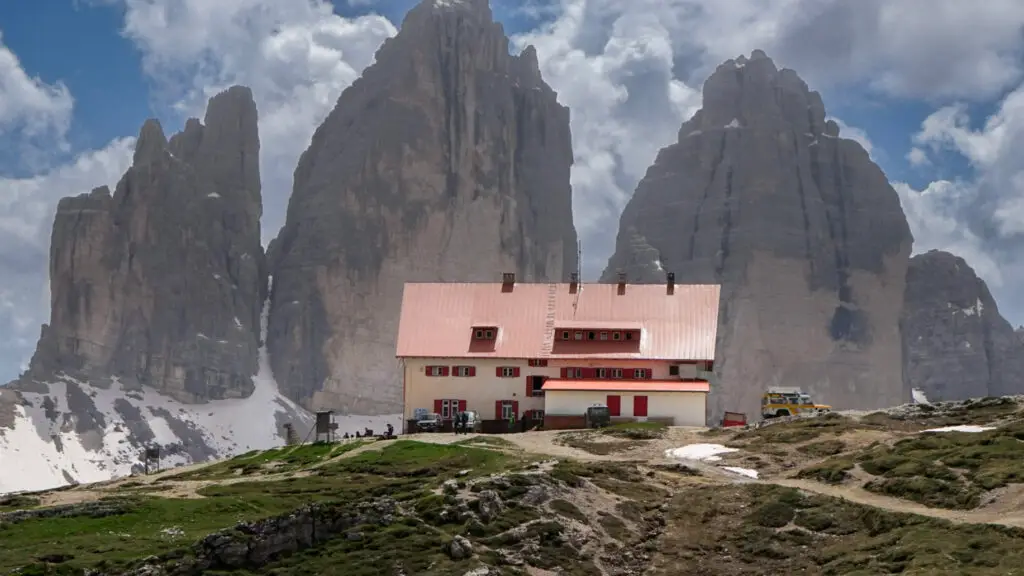
How to Get to the Dolomites
Since I live two hours south of the Dolomites, it’s easy for me to get around, but I’d tell you that renting a car to get around the Dolomites would be your best bet, especially during the off-season.
🚗 Best way to get around? Renting a car offers the most flexibility, but public transport (buses + trains) works well for major towns. If you are looking for rental car deals check out rates from RentalCars.com
Bus
From Venice to Cortina is probably the fastest option if you are taking public transportation. As of June 25th, 2024, Flixbus has two departures from Venice Marco Polo, one at 11:35 am and 6:55 pm, but please check their website for updated schedules
Flix Bus seems to have quite a few routes to Cortina from major cities like Rome and Milan.
Train
The train is also another low-cost alternative to get to the Dolomites, I’ll be utilizing the train on my next adventure to the Dolomites. Check out Omio for Bus routes and trains to get to your destinations in the Dolomites!
How to Get Around the Dolomites
Know that you can take the train from Milano, Verona, Venice, Innsbruck to cities like Bolzano and Cortina and take busses anywhere around the Dolomites. For First timers this might seem confusing but I promise you it’s easy. Last Summer I did this effortlessly.
- Dolomitibus: This service allows you to explore the Dolomites and expand your discovery radius beyond the South Tyrolean borders. The bus lines allow you to reach Cortina, Auronzo, or Arabba. You can find the current timetables on their website.
- South Tyrolean Integrated Transportation: This service operates buses that cross the province’s boundaries. Some of the lines include:
- Innichen – Sexten – Kreuzberg pass – S. Stefano di Cadore (line 440)
- Toblach – Misurina – Auronzo hut (line 444) near the Three Peaks
- Toblach – Cortina (line 445)
- Toblach – Kreuzberg pass (line 446)
- Corvara – St. Kassian – Falzarego pass (line 465)
- Arabba – Pordoi pass (line 472)
- Gröden – Pordoi pass – Gröden pass (line 471)
- Cortina Express and Dolomiti Buses: These services have daily trips going in and out of the Dolomites from Venice.
- SAD Bus Service in Val di Fassa: This service operates the following lines:
- Pozza di Fassa – Vigo di Fassa – Passo Costalunga – Bolzano (line 180)
- Dolomite passes (Passo Sella, Passo Gardena, Passo Campolongo, Passo Pordoi, Passo Fedaia) (line 471) – only in summer
Please note that the schedules may vary, and it’s always a good idea to check the latest timetables on the respective websites or at local tourist offices as things change seasonally!
Dolomites by Car or Camper
When it comes to cars and getting around the Dolomites know that because of the mountainous terrain it takes awhile to get from one destination to the next, but cars or campers are the most convenient ways to get around in the Dolomites.
Do you need to rent a car for your trip? I trust Rentalcars.com to get me where I need to go and here you can search through their extensive database of rental cars and deals
Pro-Tip➡️: Check out my Driving in Italy 5+ Important Things You Should Know Post for reassurance on driving over here.
Where to Stay in the Dolomites
Choosing where to stay in the Dolomites depends on what you want to see and do. The region is vast, with different areas catering to hikers, sightseers, and skiers. Here’s a quick guide to help you decide:
- Cortina d’Ampezzo – Best for first-timers, with easy access to famous spots like Tre Cime di Lavaredo, Lago di Sorapis, and Lago di Misurina. A great base if you’re using public transportation.
- Alta Badia (La Villa, Corvara, San Cassiano, Colfosco) – Ideal for hikers and skiers, with stunning trails, great rifugios, and a mix of hotels and self-catering apartments.
- Val Gardena (Ortisei, Selva, Santa Cristina) – Perfect for those wanting to explore Seceda, Alpe di Siusi, and some of the Dolomites’ best skiing in winter.
- Lago di Braies Area (Braies, Dobbiaco, Villabassa) – Best for a quieter retreat near the famous lake. Book early—it gets busy!
- Bressanone & Surroundings – A great starting point for Alta Via 2 and a mix of culture, history, and nature.
- Alpe di Siusi (Seiser Alm) – One of the most picturesque areas, with rolling meadows, incredible views, and a mix of luxury hotels and cozy B&Bs.
Now that you have a general idea of the regions, here are the specific places I stayed at and loved!
Remember I live 2 hours south and I absolutely head up here as much as possible. I try to stay at different places, my budget is mid-range with maybe a bit of luxury.
Sorapiss Hotel – Lago di Misurina
If you’re looking for a peaceful stay right by the lake, Sorapiss Hotel is an excellent choice. I loved being able to walk around Lago di Misurina at night, with trails just steps away. The location made it easy to reach Lago di Braies and other must-see spots. The staff was incredibly welcoming—the kind of hospitality that makes a trip memorable.

B&B Passo Tre Croci – Near Lago di Sorapis
I stayed here in April 2024 because it was one of the most convenient places for hiking Lago di Sorapis, and it’s just a short drive or bus ride to Cortina. The views were fantastic, and while the dinner options were simple, they were satisfying after a long day of exploring.
Hotel Trenker – Near Lago di Braies
If Lago di Braies is on your list, Hotel Trenker is a dream stay. This charming Alpine-style hotel has a wellness area with saunas and a panoramic indoor pool—perfect after a day of hiking. I stayed here before starting the Alta Via 1 in September, and I’m so glad I did. The staff was amazing, and they even let me borrow a backpack for day hikes! The food was incredible, and I still dream about the Ladin soup I had here—absolute perfection.
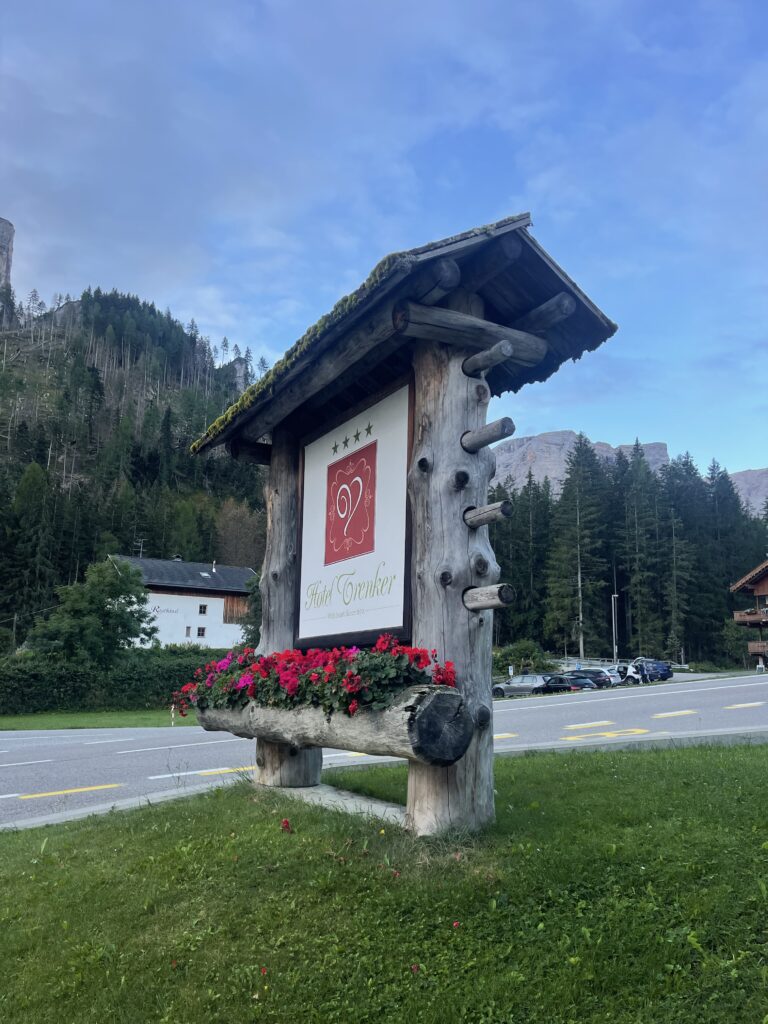
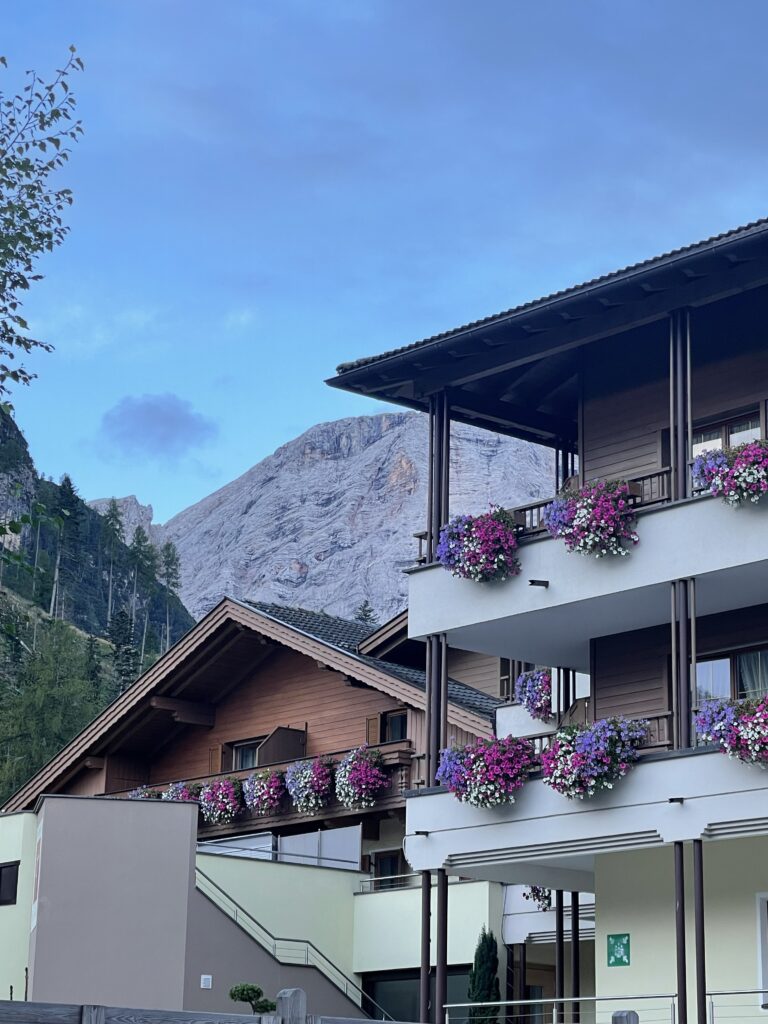
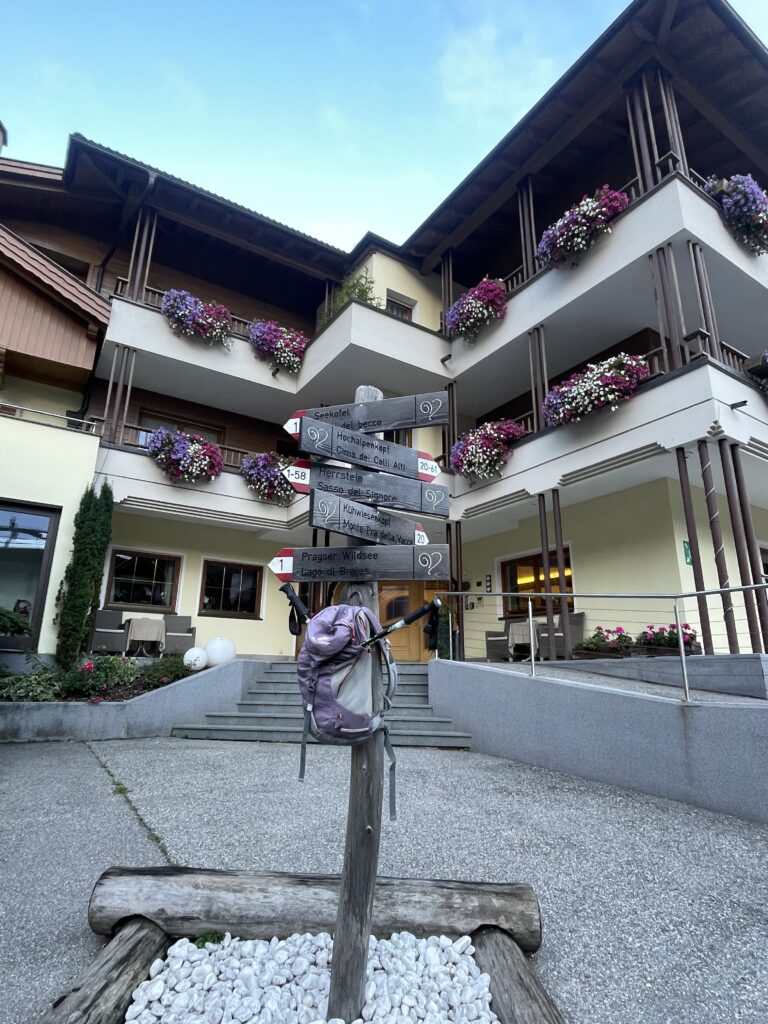
Ciasa Agreiter – Alta Badia (Dog-Friendly!)
Alta Badia is one of the most scenic areas in the Dolomites, and I picked Ciasa Agreiter for a weekend getaway because it was dog-friendly and spacious. The self-catering apartments were cozy, and the bed was incredibly comfortable—just what I needed after long days outdoors. Plus, the views of La Villa in Alta Badia were breathtaking. It’s a great option if you’re traveling with family or pets and want easy access to hiking and skiing.
Hotel Ortler – Ulten Valley (Near Alpe di Siusi)
Nestled in the quiet Ulten Valley, just outside Kastelruth/Castlerotto, this family-run hotel was my home base for visiting Alpe di Siusi. The experience was magical—staying in a cozy, mountain-view room and waking up early to hike the rolling alpine meadows. The owners were so kind, even letting me check in early so my husband and I could attend the Almatreib festival in Compatsch. Just a note: dogs aren’t allowed here, so keep that in mind if you’re traveling with pets.
Hotel Elephant – Bressanone (Start of Alta Via 2)
For a bit of luxury before tackling Alta Via 2, Hotel Elephant was the perfect stay. Set in a historic building in Bressanone, the hotel blends elegance with modern comforts, including a pool, a large park, and two restaurants, one of which is Michelin-starred. The staff was so helpful, providing directions and tips for Alta Via 2. A huge perk? They participate in a program where you get a card for buses and lifts, making it super easy to explore the area.
B&B Villa Angelino – Ortisei (End of Alta Via 2)
I stayed here after finishing my four-day trek on Alta Via 2, and it was the perfect way to end my adventure. This charming B&B in Ortisei has cozy Alpine-style rooms and a fantastic breakfast featuring local products. One of my favorite features? Their “honest bar”—you grab a snack or drink and pay what you think is fair. The staff was also super accommodating, letting me store my bag after checkout so I could visit Seceda before leaving.
Interactive Map of Places to Stay
Airbnbs are great but also keep in mind that nothing beats staying at a local inn or even in the Rifugios, you’ll get to meet locals and socialize with them.
Rifugios in the Dolomites
You might be asking yourself how you can stay the night in a Rifugio in the Dolomites. I have written two blogs about my my experience on the Alta Via 1 and 2 along with a What to Expect When You Stay at a Rifugio in The Dolomites. Both detail what its like to stay in a Rifugio.
If you are looking for information on how to book a specific Rifugio you have two options!
- You can make a reservation on this website — Club Alpino Italiano
- You can go to the specific Rifugio website and book through them.
- If you are trying to figure out which rifugios are on the Alta Via 1 and Alta Via 2 or any of the trails on your hike, you can look here
If you are doing the Alta Via 1 or Alta Via 2 it’s wise to book WAY in advance.
I found out I was too late in booking my southern Alta Via1 rifugios in January and I was heartbroken. So you it’s a good Idea to book early and research as early as possible.
Resources for you to look into for your trip to the Dolomites
Oftentimes times many people overlook tourism boards for information. Here is a great resource for you to check out below:
Alta Badia
Packing Essentials For The Dolomites
Packing the essentials is important! Please don’t do any of these hikes with Nikes or flip-flops. I hear so many horror stories about people getting hurt hiking in the wrong gear.
Safety is important and the weather changes constantly in the Dolomites! Travel Insurance as well, Travel Guard is pretty great!
- Hiking Boots: A sturdy pair of hiking boots is essential for the mountainous terrain.
- Essential Hiking Gear: Moisture-wicking socks, base layers, mid-layers for insulation, outer layers, and hats and gloves
- Backpack: A comfortable backpack to carry essentials like water, snacks, and extra layers of clothing.
- Reusable Water Bottle: Stay hydrated during your hikes!
- First Aid Kit: Essential for treating minor injuries. My husband even packed a splint for me to use.
- Sunscreen: Protect your skin from the sun’s UV rays.
- Electricity Converter or Transformer: Italy uses Type F and Type L outlets, so you may need an adapter if your devices use a different plug type.
- Camera Gear: To capture the stunning landscapes. The Dolomites are known for their beautiful landscapes and sunsets, so why not practice your photography?
- Euro Currency: You’ll want euro change for bathrooms and food at the Rifugios
- Power Bank and Extra Cord: To keep your phone charged.
Final Thoughts
The Dolomites are truly a gem for first-time travelers, offering something for everyone—whether you’re a seasoned hiker, a photography enthusiast, or simply someone looking to immerse themselves in awe-inspiring landscapes. I hope this First-Timers Guide to the Dolomites helps you plan your trip!
From exploring charming villages to conquering iconic peaks, every moment spent here will leave you with lasting memories.
Remember to plan ahead, pack wisely, and embrace the slow, intentional pace of the mountains. The Dolomites are more than just a destination—they’re an experience that will stay with you long after you leave.
So, lace up your boots, breathe in the fresh alpine air, and embark on a journey that will surely exceed your expectations. Your adventure in this stunning corner of the world is waiting!
Pin this post for future planning!
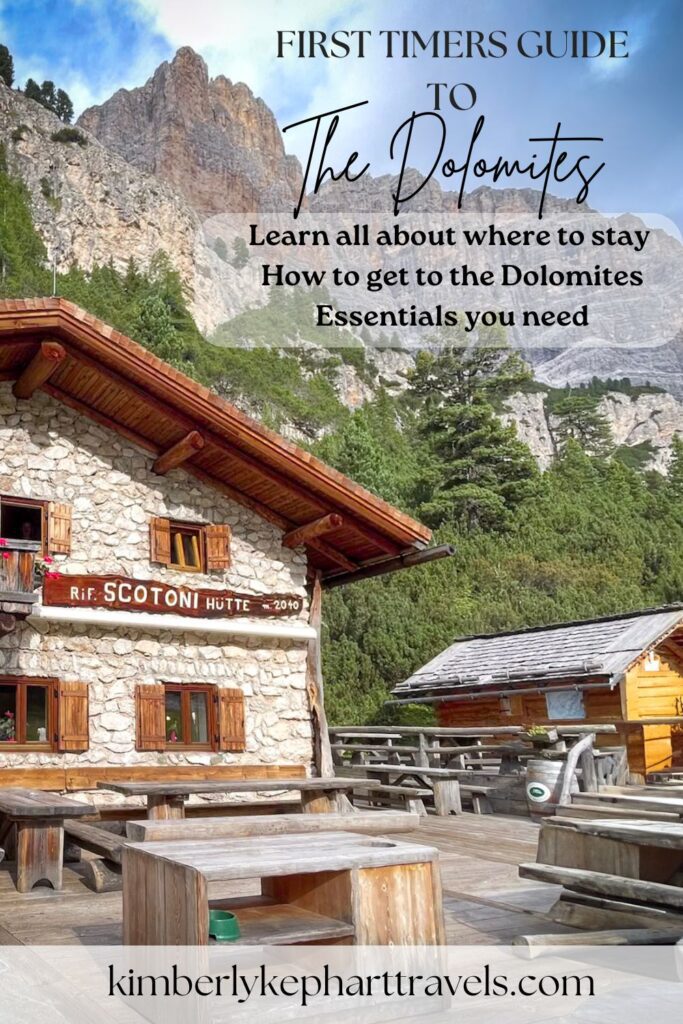
Check out my other posts related to the Dolomites⬇️
- A First Timers Guide to the Dolomites :How to Plan your trip and where to stay!
- Solo Hiking the Stunning Alta Via 1 & 2 with Bookatrekking
- Lago Di Sorapis Hiking Guide: Passo Tre Croci to Sorapiss
- What to Expect while staying at Rifugios in the Dolomites
- Your Ultimate Guide to Bolzano and Merano Christmas Markets
- Rango Christmas Market in Garda-Trentino, Italy
- Five of the Best Hikes in the Italian Dolomites You Can Do Near Cortina D’ Ampezzo
- Cadini di Misurina: The Viral Dolomites Viewpoint That’s Not Worth Your Time
- Snowshoeing in the Dolomites: An Epic Guided Adventure Around Cinque Torri
